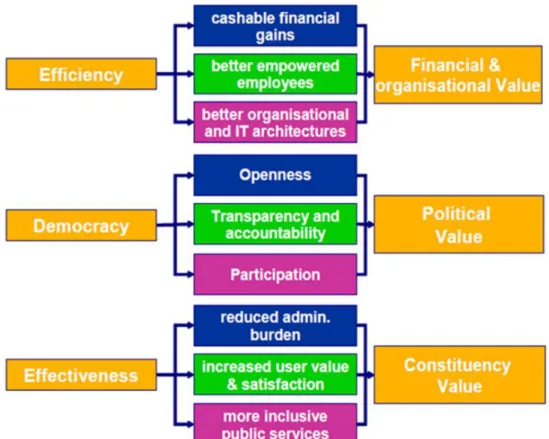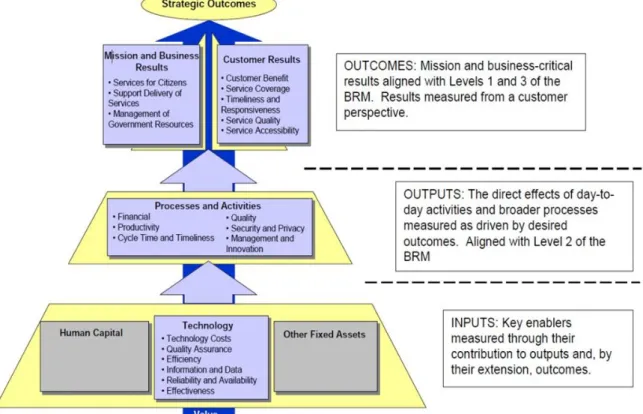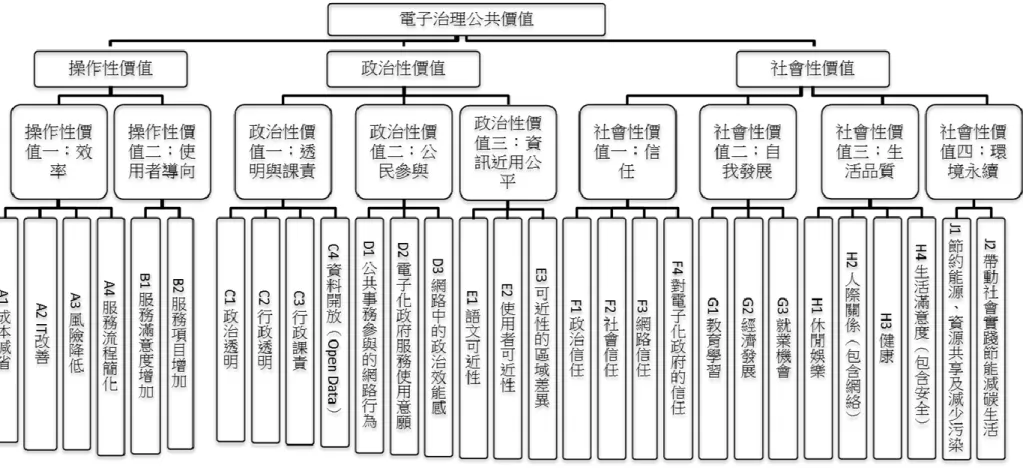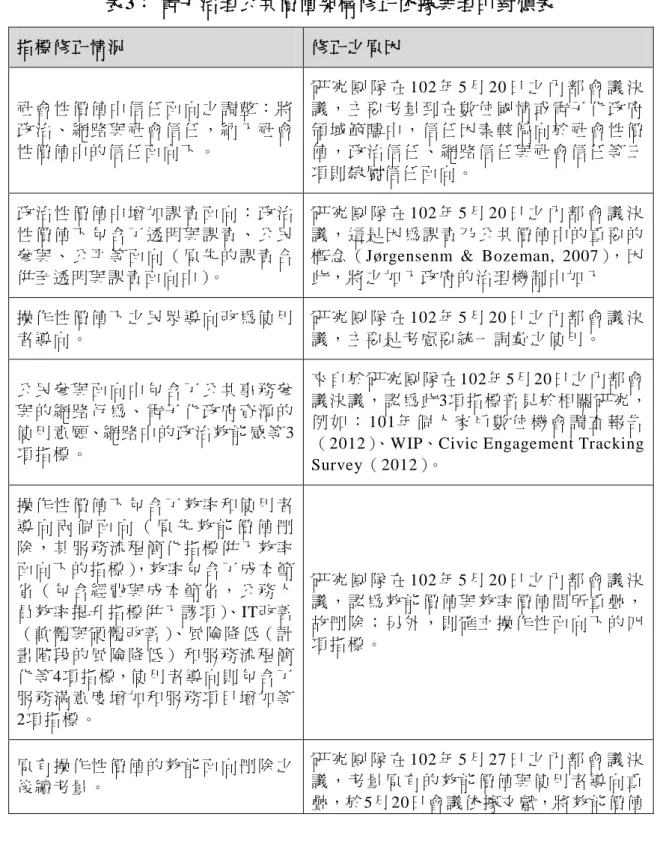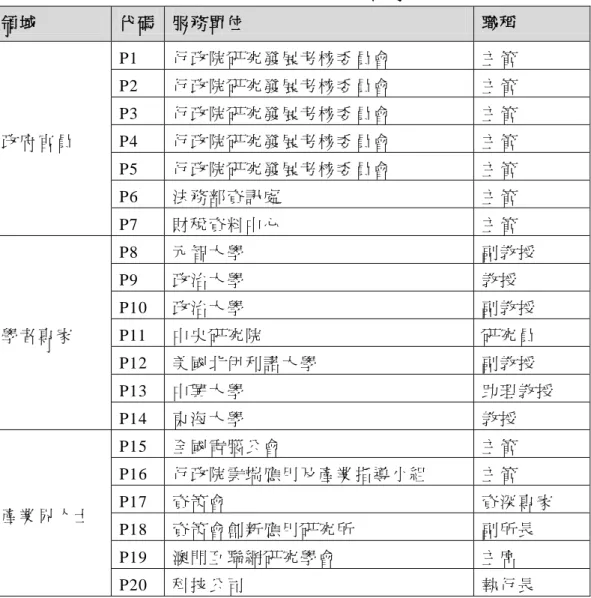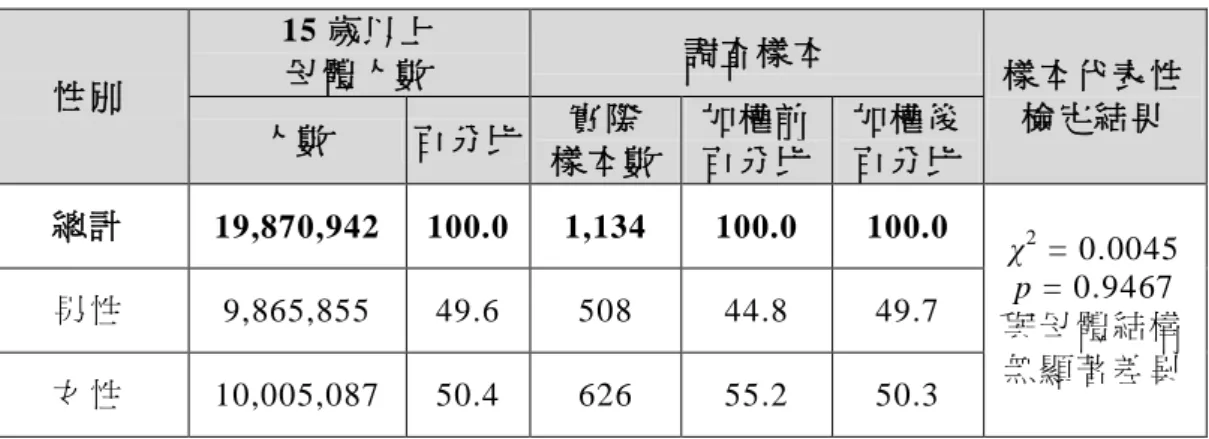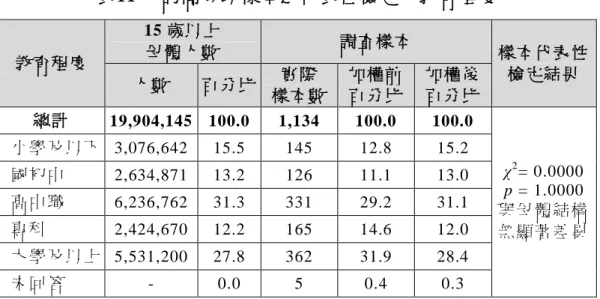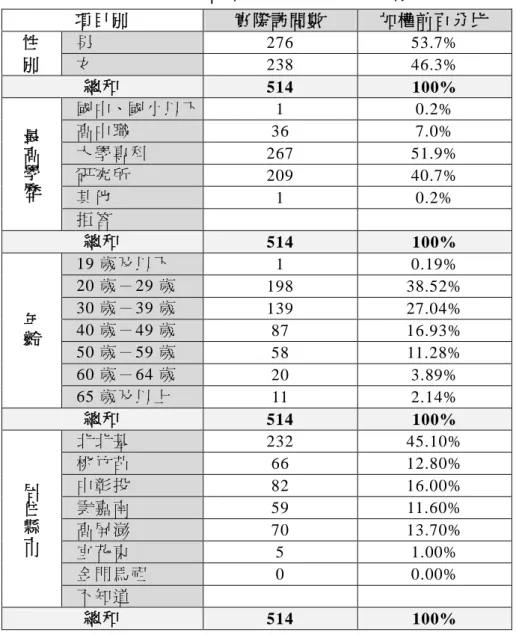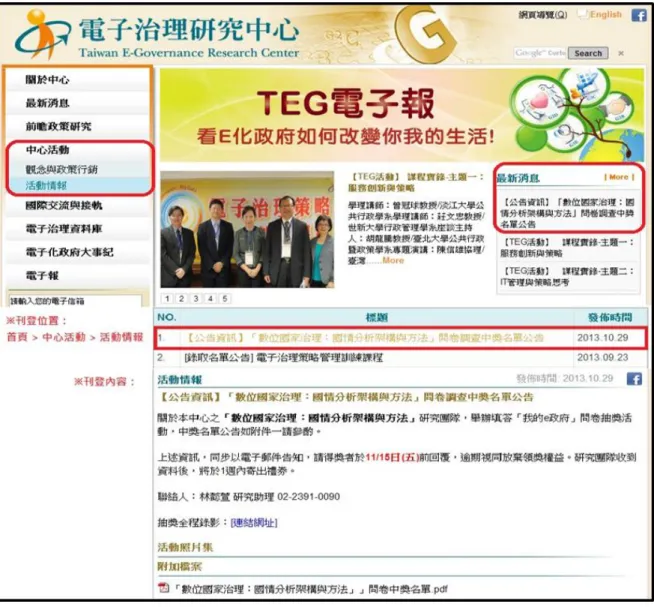數位國家治理:
國情分析架構與方法
﹙期末報告修正本﹚
行 政 院 國 家 發 展 委 員 會 編 印
中華民國 103 年 2 月
數位國家治理:
國情分析架構與方法
﹙期末報告修正本﹚
受委託單位:電子治理研究中心
研究主持人:陳俊明
協同主持人:朱斌妤、黃東益、蔣麗君、李仲彬、
張鎧如
研 究 顧 問:洪永泰、游佳萍
研 究 助 理:呂佩安、林煥笙、劉奕宏、林懿萱 、
張凱媛、柯政豪
行政院國家發展委員會編印
中華民國 103 年 2 月
﹙ 本 案 原 受 行 政 院 研 究 發 展 考 核 委 員 會 委 託 執 行 , 此 單 位 已 於 1 0 3 年 1 月 2 2 日 起 併 入 行 政 院 國 家 發 展 委 員 會 。 ﹚目次
目 次 ... I 表 次 ... III 圖 次 ... IX 提 要 ... XI Abstract ... XXI 第 一 章 緒 論 ... 1 第一 節 研究背 景 與問題 ... 1 第二 節 研究目 的 ... 3 第三 節 研究方 法 ... 4 第 二 章 文 獻分析 ... 7 第一 節 「公共 價 值」對 電 子治理 衡 量的重要 性 ... 7 第二 節 國際現 有 電子治 理 公 共 價值面向 ... 11 第三 節 國際評 比 指標與 電 子治理 公 共價值的 連結 ... 18 第 三 章 架 構提出 與 方法設 計 ... 23 第一 節 以公共 價 值為基 礎 的電子 治理架 構 ... 23 第二 節 指標權 重 分析- 層 級分析 法 的運用 ... 40 第三 節 架構的 測 量-客 觀 指標的 建 構 ... 45 第四 節 主觀指 標 之設計 與 調查 ... 57 第 四 章 電 子治理 公 共價值 指 標-層 級 分析結 果 ... 77 第一 節 電子治 理 公共價 值 整體評 估 層級分析 結果 ... 77 第二 節 電子治 理 公共價 值 比 較 :學術 v.s.實務 ... 87 第 五 章 數 位國情 架 構之跨 國 檢視─ 美 國、英 國、新加坡 ... 93 第一 節 美國 ... 94 第二 節 英國 ... 102 第三 節 新加坡 ... 110 第四 節 美國、 英 國、新 加 坡三國 比 較分析 ... 122第 六 章 我 國數位 國 情-主 觀 指標試 驗 性調查 結果 ... 131 第一 節 以操作 性 價值為 基 礎的數 位 國情 ... 132 第二 節 以政治 性 價值為 基 礎的數 位 國情 ... 139 第三 節 以社會 性 價值為 基 礎的數 位 國情 ... 153 第四 節 小結 ... 183 第 七 章 數 位國情 主 觀指標 調 查方法 的 比較分 析 ... 187 第一 節 執行效 率 與資料 信 效度比 較 ... 188 第二 節 有線電 話 使用及 手 機使用 涵 蓋率的比 較 ... 193 第三 節 網路使 用 情形與 政 府網站 使 用頻率比 較 ... 196 第四 節 樣本的 人 口背景 比 較 ... 198 第五 節 網路使 用 者人口 背 景比較 ... 203 第六 節 政府機 關 網站使 用 者人口 背 景比較 ... 208 第七 節 小結─ 主 觀指標 調 查方法 的 建立 ... 213 第 八 章 結 論 ... 217 第一 節 研究發 現 ... 217 第二 節 研究限 制 與後續 研 究發展 ... 226 第三 節 政策建 議 ... 230 參 考 文獻 ... 239 附 錄 ... 249 附錄 一、 近六 年應用層級分析在電子治理研究之中外文獻 ... 249 附錄 二、 AHP 正式問卷 ... 252 附錄三、 美、英、新加坡電子治理政策與電子治理公共價值架構 之 分 析 ... 264 附錄 四、 電訪、網路與政府網路使用者調查問卷 ... 280 附錄 五、 手機問卷 ... 289 附錄 六、 TEDS2013 題目加掛申請 ... 293 附錄 七、 臺灣電子治理研究中心歷年研究計畫重點 ... 299 附錄 八、 電子治理公共價值架構客觀型測量次指標 ... 305 附錄 九、 期中報告審查意見與回應 ... 315 附錄 十、 期末報告審查意見與回應 ... 319
表次
表 1: 我 國 PVIT 評 估 模式 與 本 研究 電 子 治 理 公共 價 值 之對 應 ... 27 表 2: 電 子 治 理公 共 價 值架 構 指 標定 義 ... 34 表 3: 電 子 治 理公 共 價 值架 構 修 正依 據 與 理 由 對應 表 ... 38 表 4: 本 研 究 層級 分 析 問卷 填 答 專家 名 單 ... 44 表 5: 電 子 治 理公 共 價 值 架 構 中 客觀 性 次 指 標 來源 與 數 量 ... 56 表 6: 電 子 治 理公 共 價 值架 構 中 主觀 性 次 指 標 (問 卷 題 目) ... 58 表 7: 各 調 查 方法 ... 63 表 8: 各 調 查 方法 的 題 目內 容 ... 64 表 9: 訪 問 成 功樣 本 之 代表 性 檢 定 -性 別 ... 66 表 10: 訪 問 成 功樣 本 之 代表 性 檢 定- 年 齡 ... 66 表 11: 訪 問 成 功樣 本 之 代表 性 檢 定- 教 育 程 度 ... 67 表 12: 訪 問 成 功樣 本 之 代表 性 檢 定- 地 區 ... 67 表 13: 手 機 調 查加 權 前 後樣 本 結 構 ... 69 表 14: 網 路 調 查加 權 前 後樣 本 結 構 ... 71 表 15: 政 府 網 站會 員 調 查的 樣 本 結構 ... 74 表 16: 電 子 治 理公 共 價 值整 體 專 家權 重 ... 78 表 17: 電 子 治 理公 共 價 值第 二 層 權重 值 表 ... 80 表 18: 電 子 治 理公 共 價 值政 治 性 價值 第 三 層 層 級分 析 表 ... 81 表 19: 電 子 治 理公 共 價 值政 治 性 價值 第 四 層 層 級分 析 表 ... 82 表 20: 電 子 治 理公 共 價 值社 會 性 價值 第 三 層 層 級分 析 表 ... 83表 21: 電 子 治 理公 共 價 值社 會 性 價值 第 四 層 層 級分 析 表 ... 84 表 22: 電 子 治 理公 共 價 值操 作 性 價值 第 三 層 層 級分 析 表 ... 85 表 23: 電 子 治 理公 共 價 值操 作 性 價值 第 四 層 層 級分 析 表 ... 86 表 24: IT 改 善 1- 政 府 更換 新 資 訊通 訊 系 統 的 頻率 ... 133 表 25: IT 改 善 2- 政 府 更換 新 資 訊通 訊 設 備 的 頻率 ... 134 表 26: 服 務 流 程簡 化 1-電 子 治 理對 民 眾 洽 公 手續 簡 化 的影 響 ... 135 表 27: 服 務 流 程簡 化 2-電 子 治 理對 民 眾 洽 公 需接 觸 單 位數 影 響 ... 136 表 28: 服 務 滿 意度 增 加 1- 民眾 對 政 府網 站 提 供資 訊 的 滿意 度 ... 137 表 29: 服 務 滿 意度 增 加 2- 民眾 對 政 府網 站 上 提供 的 服 務滿 意 度 ... 138 表 30: 服 務 項 目增 加 1-民 眾 可 以得 到 的 政 府 服務 量 改 變的 狀 況 ... 139 表 31: 政 治 透 明 1- 從 政府 網 站 找到 法 律 規 定 相關 資 訊 的容 易 度 ... 140 表 32: 政 治 透 明 2- 從 政府 網 站 找到 與 政 策 相 關資 訊 的 容易 度 ... 141 表 33: 行 政 透 明 1- 從 網路 上 查 到政 府 線 上 服 務的 流 程 的容 易 度 ... 142 表 34: 行 政 透 明 2- 從 網路 上 查 到政 府 線 上 服 務處 理 進 度的 容 易 度 ... 143 表 35: 行 政 課 責 1- 容 不容 易 找 到業 務 承 辦 人 來處 理 問 題 ... 144 表 36: 公 共 事 務參 與 的 網路 行 為 1- 透過 社 群 網站 傳 遞 公共 議 題 ... 145 表 37: 公 共 事 務參 與 的 網路 行 為 2- 參加 網 路 舉辦 、 號 召現 場 活 動 ... 146 表 38: 公 共 事 務參 與 的 網路 行 為 3- 網路 討 論 區提 出 公 共問 題 看 法 ... 147 表 39: 公 共 事 務參 與 的 網路 行 為 3( 追問 題 ) -使 用 政 府網 站 比 例 ... 148 表 40: 電 子 化 政府 服 務 使用 意 願 1- 透過 政 府 網站 做 「 線上 申 請 」 ... 149 表 41: 電 子 化 政府 服 務 使用 意 願 2- 未來 是 否 願意 使 用 政府 設 立 網 站 . 150 表 42: 網 路 中 的政 治 效 能 感 1 ... 151 表 43: 網 路 中 的政 治 效 能 感 2 ... 152
表 44: 可 近 性 的區 域 差 異- 地 方 政府 所 提 供 電 腦網 路 服 務方 便 度 ... 153 表 45: 政 治 信 任 1- 同 不同 意 「 政府 所 做 的 事 大多 數 是 正確 的 」 ... 154 表 46: 政 治 信 任 2- 政 府決 定 政 策時 會 不 會 優 先考 慮 「 民眾 的 福 利 」 . 155 表 47: 政 治 信 任 3- 相 不相 信 政 府首 長 在 電 視 或報 紙 上 所說 的 話 ... 156 表 48: 社 會 信 任 1- 對 於現 在 的 生活 環 境 安 不 安心 ... 157 表 49: 社 會 信 任 2- 認 不認 為 一 般人 是 可 以 信 任的 ... 158 表 50: 網 路 信 任 1- 網 路上 的 朋 友能 不 能 信 任 ... 159 表 51: 網 路 信 任 2- 網 路上 的 資 訊是 能 不 能 相 信 ... 160 表 52: 對 電 子 化政 府 的 信 任 1- 相 不 相信 政 府 網站 提 供 的資 訊 ... 161 表 53: 對 電 子 化政 府 的 信 任 2- 政 府 網站 上 提 供的 資 訊 可不 可 靠 ... 162 表 54: 對 電 子 化政 府 的 信 任 3- 相 不 相信 政 府 透過 網 路 能處 理 好 事 情 . 163 表 55: 教 育 學 習 1- 利 用網 路 來 查證 資 料 的 頻 率 ... 164 表 56: 教 育 學 習 2- 利 用網 路 上 課或 接 受 工 作 訓練 的 頻 率 ... 165 表 57: 經 濟 發 展 1- 在 網路 上 查 詢商 品 資 訊 的 頻率 ... 166 表 58: 經 濟 發 展 2- 網 路購 物 的 頻率 ... 167 表 59: 經 濟 發 展 3- 透 過網 路 拍 賣東 西 的 頻 率 ... 168 表 60: 經 濟 發 展 4- 用 電腦 網 路 訂車 票 、 旅 館 或機 票 的 頻率 ... 169 表 61: 經 濟 發 展 5- 利 用電 腦 網 路來 繳 帳 單 的 頻率 ... 170 表 62: 經 濟 發 展 6- 使 用網 路 銀 行處 理 金 融 帳 戶的 頻 率 ... 171 表 63: 就 業 機 會 1- 透 過網 路 找 尋工 作 資 訊 或 投遞 履 歷 的頻 率 ... 172 表 64: 休 閒 娛 樂 1- 利 用網 路 搜 尋藝 文 資 訊 或 活動 的 頻 率 ... 173 表 65: 休 閒 娛 樂 2- 觀 賞網 路 上 影音 資 料 、 從 事線 上 遊 戲的 頻 率 ... 174 表 66: 休 閒 娛 樂 3- 在 網路 上 瀏 覽旅 遊 資 訊 的 頻率 ... 175
表 67: 人 際 關 係 1- 使 用線 上 通 訊軟 體 和 別 人 聯絡 的 頻 率 ... 176 表 68: 人 際 關 係 2- 使 用「 網 路 」打 電 話 的 頻 率 ... 177 表 69: 人 際 關 係 3- 使 用「 臉 書 ( Facebook) 」的 頻 率 ... 178 表 70: 人 際 關 係 4- 上 網後 和 家 人聊 天 、 吃 飯 、在 一 起 時間 的 變 化 ... 179 表 71: 人 際 關 係 5- 上 網後 和 朋 友聊 天 、 吃 飯 、在 一 起 時間 的 變 化 ... 180 表 72: 健 康 1- 透 過 網 路搜 尋 和 身體 健 康 有 關 資訊 的 頻 率 ... 181 表 73: 生 活 滿 意 度 1- 透過 網 路 搜尋 居 家 附 近 生活 資 訊 的頻 率 ... 182 表 74: 生 活 滿 意 度 2- 有網 路 後 生活 後 的 快 樂 程度 變 化 ... 183 表 75: 不 同 調 查方 法 的 成功 率 ... 188 表 76: 電 話 調 查與 手 機 調查 撥 打 回應 分 析 ... 189 表 77: 不 同 調 查方 法 的 成本 與 效 率分 析 ... 190 表 78: 不 同 調 查中 「 信 任」 面 向 的 Cronbach's α 值 ... 191 表 79: 信 任 面 向因 素 分 析分 析 結 果比 較 ... 192 表 80: 不 同 調 查方 法 中 受訪 者 電 話擁 有 狀 況 ... 194 表 81: 不 同 調 查方 法 中 受訪 者 電 話使 用 情 形 ... 195 表 82: 不 同 調 查方 法 受 訪者 網 路 使 用 情 形 ... 197 表 83: 不 同 調 查方 法 中 受訪 者 使 用政 府 網 站 的 比率 ... 198 表 84: TEDS 次 母 群 分 類方 法 ... 199 表 85: 不 同 調 查方 法 比 較- 整 體 受訪 者 性 別 ... 200 表 86: 不 同 調 查方 法 比 較- 整 體 受訪 者 年 齡 ... 201 表 87: 不 同 調 查方 法 比 較- 整 體 受訪 者 教 育 程 度 ... 202 表 88: 不 同 調 查方 法 比 較- 整 體 受訪 者 居 住 地 區 ... 203 表 89: 不 同 調 查方 法 比 較- 網 路 使用 者 的 網 路 使用 程 度 ... 204
表 90: 不 同 調 查方 法 比 較- 網 路 使用 者 性 別 ... 205 表 91: 不 同 調 查方 法 比 較- 網 路 使用 者 年 齡 ... 206 表 92: 不 同 調 查方 法 比 較- 網 路 使用 者 教 育 程 度 ... 207 表 93: 不 同 調 查方 法 比 較- 網 路 使用 者 居 住 縣 市 ... 208 表 94: 不 同 調 查方 法 比 較- 政 府 網站 使 用 程 度 ... 209 表 95: 不 同 調 查方 法 比 較- 政 府 網站 使 用 者 性 別 ... 210 表 96: 不 同 調 查方 法 比 較- 政 府 網站 使 用 者 年 齡 ... 211 表 97: 不 同 調 查方 法 比 較- 政 府 網站 使 用 者 教 育程 度 ... 212 表 98: 不 同 調 查方 法 比 較- 政 府 網站 使 用 者 居 住縣 市 ... 213
圖次
圖 1: 電 子 化 政府 公 共 價值 評 估 指標 分 析 架 構 圖 ... 12
圖 2: 法 國 「 價值 分 析 暨增 進 法 」分 析 架 構 ( 雷達 圖 ) ... 13
圖 3: 美 國 聯 邦企 業 架 構規 範( FEA)之 績 效 參考 模 式 架構( Performance Reference Model Framework) ... 14
圖 4: 我 國 電 子化 政 府 計畫 成 效 評估 架 構 ... 17 圖 5: 電 子 治 理公 共 價 值初 始 架 構圖 ... 24 圖 6: 電 子 治 理公 共 價 值分 析 架 構之 概 念 性 思 維 ... 26 圖 7: 修 正 後 電子 治 理 公共 價 值 分析 架 構 ( 第 三層 次 的 確立 ) ... 30 圖 8: 完 整 電 子治 理 公 共價 值 架 構圖 ... 33 圖 9: 102 年 數 位 國情 調 查中 獎 公 告 ... 73 圖 10: 政 府 數 位服 務 模 型 ... 99 圖 11: IT 服 務 分 享 概 觀 ... 101 圖 12: 新 加 坡 eGov2015 願景 與 策 略 ... 112 圖 13: 新 加 坡 eGov2015 計畫 中 之 方 案( 提 供 給公 民 ) ... 113 圖 14: 新 加 坡 eGov2015 計畫 中 之 方 案( 提 供 給政 府 ) ... 115 圖 15: 新 加 坡 財政 部 與 資訊 發 展 局在 電 子 化 政 府中 之 扮 演角 色 ... 116 圖 16: 對 各 價 值、 面 向 、指 標 「 正面 表 述 」 受 訪者 佔 總 樣本 的 百 分 比 185
提要
關鍵字:數位 國家治 理、電子治理 公共價 值、層級分析 法、多 重調查 方法 、前瞻 研 究一、 研究緣起與目的
目前學術界 或實務界 所提供的各 項國際電 子治理評比 指標,雖 然 各有其重要性 ,但鮮 少觸及一個更 基本的 問題,那就是 國家推 動數位 化的價值目標 究竟為 何?資訊與通 訊科技 的普遍應用, 改變了 當前人 類生活型態, 也影響 到政府治理的 規劃與 執行。從良善 治理的 角度來 看,在世界各 國普遍 應用資訊與通 訊科技 ,以求政府再 造、提 升綜效 的同時,電子 治理亦 須兼顧參與、 公平、 透明、課責、 永續等 公共價 值,以免落入 效率掛 帥的「單面向 」治理 。換言之,資 訊與通 訊科技 發 展 與應 用的 目的 ,應 以回 應 公 共價值 為 依歸。 然而,分析 當前國際 電子治理評 比指標的 相關文獻不 難得知, 目 前的評比項目,多偏重基礎建設與操 作面向,雖逐漸重視政治面向(例 如透明、課責 、公民 參與等),缺 社會與 永續價值面向 的討論 卻付之 闕如。此外, 目前大 部分的國際評 比項目 都屬於客觀資 料的型 態,即 政府機關的統 計資料 ,前述文獻對 這些客 觀資料與公共 價值的 對應, 極少討論與分 析。事 實上,全面性 地瞭解 一個國家的數 位國情 ,單賴 客 觀 資 料 與 指 標 難 稱 全 面 , 如 能 兼 及 使 用 者 的 主 觀 評 量 或 可 較 為 周 延,有鑑於當 前國際 性的評比甚少 著墨於 使用者的認知 及態度 等主觀 調 查 , 因 此 如 何 妥 適 地 蒐 集 客 觀 資 料 與 有 效 的 調 查 使 用 者 的 主 觀 意 見,建置一個 以公共 價值為基礎的 電子治 理架構及其相 關指標 ,從而 據 以 進行數位國 情 調查, 也 就成為 本 團隊從事 本研究 的初衷。 具體而言, 本研究所 積極探索的 主要問題 ,包括國家 發展電子 治 理所應追求的 事哪些 最終公共價值 ?追求 這些價值應透 過哪些 實踐面 向來呈現?透 過哪些 資訊以便了解 目前電 子治理的發展 成果? 為了追求上述問題的 答案, 本研究的核心 工作就 是透過建置電 子治理 公共價 值(public value of electronic governance)架構以分析數位國情,並選 擇若干主觀指 標,對 一般民眾進行 不同方 式的先導性調 查,嘗 試從使 用者主觀評估 的角度 ,了解我國電 子治理 的推動狀況, 以供政 府在有 限的資源中得 以排列 施政的優先順 序。此 外,本研究團 隊也試 圖同步 運用不同的調 查方法 ,測試本研究 所建構 出的架構,檢 視各種 調查方 法間所可能存 在的差 異,期能有助 於執行 後續相關主觀 意見衡 量時, 選 擇 較佳 調查 方法 組合 之用 。
二、 研究方法及流程
本研 究三 個階 段中 ,所 採行的 研 究方法, 概述如 下: (一 ) 電 子治 理公 共價 值架 構 與 指標的 建立:透過文 獻檢閱及層 級分 析 法(Analytical Hierarchy Process, 後文以 AHP 稱之 )蒐集 專家意見,建構電子 治理公共價值基本架構,以及各面向與對 應 指標 和指 標權 重。 (二 ) 電 子治 理指 標實 證調 查 及 方法 評 析:依 據 前 一 階 段 完 成 之 架 構 , 研 擬各 面向 及指 標之 測 量 操作。 其後透過對 專家 AHP 問卷資 料的計算,確立分析 架構中各面向與指標權重,以便進行指標 測 量及 實證 資料 蒐集。在客 觀 指標方 面,主要 是參考國內 外政 府 及國 際組 織之 統計 資 料;在 主觀指 標方 面,則由彙整 相關文 獻檢閱、國內外電子 治理議題研究經驗後,設計結構式問卷。 其中,實證資料之蒐集係透過以國內民眾為對象的主觀調查的 方式進行,所涉及的 多元調查管道,包含 政治大學選舉研究中 心 及行 政院 國家 發 展委員 會 的網路 調查;專業民 意調查機構 的 行 動電 話與 市內 電話 調 查;政 治大學選 舉研究 中心之臺灣 選 舉 與 民 主 化 調 查 專 案 (Taiwan’s Election and Democratization Study, TEDS) 進行 面 訪 。在分 析 上述各 種調查管道 及其調 查 結果後,應能有效掌 握不同調查方式之信、效度及差異所在。 (三 ) 未 來電 子治 理政 策與 研 究 議題的 建議:研究團 隊綜整前二 階段成果,就未來政府的電子治理政策與後續值得進一步探討的議 題 研提 相關 建議 。
三、 初步成果
(一 ) 本 研 究 提 出 的 電 子 治 理 公 共 價 值 架 構 其 中 之 三 大 價 值 分 別 為 : 1、 操作性 價 值:包 括 效率與 使 用者導向 兩個面 向。其中效 率面 向包含成本節省、IT 改善、風險降低、服 務流程簡化等 四項 指標; 使 用者導 向 面向 則包括 服 務滿意 度增加以及 服務項 目 增加 兩 項 指 標。 2、 政治性 價 值:包 括 透明與 課 責、公民 參與與 資訊近用公 平 等 三個面向。其中,透明與課責面向包含政治透明、行政透明、 行政課 責 、以及 資 料開放 等 四 項 指標;公民 參與面 向包括公 共事務 參 與的網 路 行為、 電 子化政府 服務使 用意願、以 及網 路政治 效 能感等 三項 指 標;資 訊 近用公 平面向則包 含語文 可 近性、 使 用者可 近 性、以 及 可近性的 區域差 異等 三項指 標。 3、 社會性 價 值:包 括 信任、 自 我發展、 生活品 質與環境永 續四 個面向 。 其中, 信 任面向 包 括政治信 任、社 會信任、網 路信 任、以 及 對電子 化 政府 的信任 等 四項 指標; 自我發展面 向包 含教育 學 習、經 濟 發展、 就 業機會等 三項指 標;生活品 質面 向包括 衡 量休閒 娛 樂、人際關 係( 包含網 絡 )、健康、以及 生 活滿意 度 (包括 安 全)等 四項 指 標;環 境永續面向 包括關 注 的是節 約 能源、 資 源共享 及 減少污染 ,以及 帶動社會實 踐節 能減碳 之 生活 兩 項指 標 。 (二 ) 本 研究 依據 電子 治 理公共 價 值分析 架構設計 AHP 專家問 卷, 並 邀請 分別 來自 政府 、 學 界與業 界等 20 位專家分別填答,結 果 發現 : 1、 專家整 體 意見 顯示 三 大 類公共 價 值重要 性依序為 : 政治 性價 值、社會性價值、操作性價值。2、 專家整 體 意見最 看 重的前 五 大電子治 理公共 價值面向 依序 為: 透明與課責、使用者 導向、效率、資訊近 用公平、公民參與; 在面向 下 ,專家 們 最看重 的 五大指標 依序為 :服務滿意 度增 加、政 治 透明、 可 近性的 區 域差異、 公共事 務參與的網 路行 為、以 及 健康。 3、 比較不 同 專家在 政 治性價 值 、社會性 價值、 操作性價值 看法 間的差 異 , 結 果發 現 : 學者專 家 比較重 視社會性價 值,其 次 為操作 性 價值, 最 後是政 治 性價值; 政府及 業界等實務 專家 所看重 的 則依序 為 政治性 價 值、社會 性價值 和操作性價 值。 4、 在政治 性 價值中 , 無論學 者 專家或實 務專家 都認為透明 與課 責是政 治 性價值 中 最重要 的 面向。 5、 在社會 性 價值部 分 ,專家 們 的整體權 重中 , 信任和生活 品質 獲得較 高 權重, 不 過,學 者 專家和實 務專家 對於社會性 價值 第三層 的 看法有 異 ,實務 專 家所給權 重由高 至低依序為 生活 品質、 信 任、環 境 永續與 自 我發展; 學者專 家的權重則 依序 是信任 、 自我 發展 、 生 活品質 與 環境永 續。 6、 在操作 性 價值的 部 分,專 家 們整體的 權重在 使用者導向 面向 和效率 面 向差異 不 大,但 相 對於學者 專家重 視使用者導 向, 實務專 家 顯然更 重 視效率 , 這可能跟 實務專 家傳統上多 以效 率、利 潤 為先的 目 標導向 價 值觀有關 係。 (三 ) 電 子治 理公 共價 值架 構 下,美 國、英 國、新 加坡三 國現況的比 較分析:研究團隊綜 合國外電子治理發展趨勢相關文獻、各 項 國 際間 電子 化政 府評 比 指 標後,針對美 國、英國、新加坡等電 子 治理 國際 評比 績優 的 國 家,以電子參 與、電子服務、電子安 全 及電 子行 政等 四個 面 向,連 結電子治 理與公 共價值二大 概念, 進 行對 上述 三國 電 子治理 政 策的分 析。結果發 現: 1、 美國、 英 國、新 加 坡三國 , 在政治性 價值的 部分,三國 大都 有在透 明 與課責 、 公民參 與 、資訊近 用公平 等面向,提 出相 關政策 。
2、 社會性 價 值的部 分 ,新加 坡 政策在社 會性價 值方面的發 展, 比美國 與 英國 快速 。 3、 操作性 價 值的部 分 ,三國 在 效率這個 面向上 ,都積極提 出各 自的政 策 措施來 強 化電子 治 理效率; 在使用 者導向面向 上, 則可見 英 國 特 別著 重 於 服務項 目 增加的 部分。 4、 整體來 看 ,三國 的 未來發 展 策略都致 力於政 府雲端運算 技術 的推動 , 期使政 府 能以更 迅 速和安全 的方式 獲取資訊, 公務 人員能 善 用跨部 門 資訊交 換 平台,強 化有效 溝通、知識 分享 以及電 子 化政府 資 訊與資 源 的運用能 力。 (四 ) 客 觀指 標的 蒐集 與建 構 1、 本研究 的 國際客 觀 指標, 主 要參照自 八 個不 同的國際評 比報 告,最 後 實際引 用 了 六 個國際 評 比報告 共 八 項指標, 它們 分 別是 ITU(2011)、ITU(2012)、UN(2012)、UN-Municipal (2012)、WEF(2012)、和 Brown University(2008)的國 際評比 報 告。值 得 一提的 是 ,國際客 觀指標 獲本團隊採 用的 比例並 不 高,主 要 原因在 於 大部分的 國際 指 標都偏向電 子化 的基礎 建 設,與 電 子治理 所 追求的公 共價值 有所差異, 並不 適合於 以 公共價 值 為基礎 的 電子治理 國情衡 量。 2、 本研究 最 後所 採納 的 八 項國際 指 標分別 是 : 有關操作性 價值 的部分 , 效率面 向 中, IT 改善指標下的「 政府採購 IT」;有 關政治 性 價值的 部 分,透 明 與課責面 向中, 政治透明指 標下 的「電 子 化資訊 」、 資 料 開放指 標下的「政 府資料 庫」, 資訊 近用公平面向中,語文可近性指標下的「多國語言」、使用者 可近性 指 標下的 「 視障者 對 網站的可 及 性」、「聽障者對網站 的可及性」、「無障礙存取」;有關社會性價值的部分,生活品 質面向 中 ,人際 關 係(包 含 網絡)指 標下的 「虛擬社群 網絡 的使用」。 3、 由於國 際 間的調 查 並不完 全 適合評比 我國的 發展現況,因 此, 本研究 另 於參考 國 內相關 客 觀指標後 ,自行 研擬指標以 評量
我國電 子 治理公 共 價值的 數 位國情, 對於彌 補國際指標 的不 足,甚 至 使之更 見 周延, 應 有一定助 益。 (五 ) 我 國主 觀性 指標 數位 國 情 調查結 果 1、 目前我 國 電子治 理 公共價 值 的呈現, 不論是 操作性價值 、政 治性價 值 或是社 會 性價值 , 各有部分 面向的 實現程度不 佳。 2、 在操作 性 價值當 中,以服 務 流程簡 化面向 下,「洽公所需接觸 的單位數」,最有改進的空間。 3、 政治性 價 值當 中, 則 以 「行政 透 明」、「 行政課 責」、「 公共事 務參與 行 為」等 三 項,為 最 需要努力 的部分 。 4、 至於社 會 性價值 的 部分, 比 較不足的 面向是 和「信任」 有關 係的幾 個 指標, 包 含政治 信 任、部分 的社會 信任與部分 的網 路信任 的 指標; 而 「自我 發 展」面向 當中幾 個指標,像 是透 過網路 進 行商業 交 易的行 為 等,也是 需要改 善的項目; 至於 生活滿 意 度面向 中 的「生 活 安全」以 及「快 樂感」的正 面表 述程度 亦 偏低。 5、 即使都 是 以網路 使 用族群 為 調查對象 ,不同 方法的調查 結果 皆出現 相 當大的 差 異,顯 示 未來的相 關研究 勢必無法忽 略對 多元調 查 方法的 討 論。 6、 透過主 觀 性指標 來 衡量操 作 性價值受 到相當 的限制,故 在未 來的研 究 當中, 相 關題目 是 否還適合 詢問一 般民眾,或 是否 適合用 主 觀性的 指 標進行 測 量,或若要 透過民眾的 調查方 法, 是否仍 應 用傳統 的 電話調 查 等問題, 都有待 進一步的討 論。 (六 ) 對 於多 元調 查方 法的 比 較 分析 1、 本 研 究 以「 臺 灣 選 舉 與 民 主 調 查 研 究( TEDS)」的面訪資料, 檢視其他調查 方法資 料分布的情形 ,結果 顯示, 若以 TEDS 調查結 果 之次母 群( 手機族、市 內電話族 )為正確母 體比例 , 則傳統 市 內電話 調 查或是 手 機調查所 接觸到 的樣本,不 論在 性別、年齡、教育程 度、居住地區、網路 使用情形等變數上,
都出現 高 估或低 估 的現象 。 2、 根據本 研 究透過 不 同方式 所 蒐集的資 料,隨 著網際網路 以及 手機的 普 及,已 有 部分的 民 眾因為仰 賴手機 通訊,而少 用或 不用有 線 電話, 故 採用傳 統 的有線電 話調查 有可能漏掉 一部 分的受 訪 者。 3、 在電話 調 查以及 手 機調查 的 受訪者中 ,各有 七成以及八 成的 比例使 用 網路, 其 中每天 使 用網路的 重度使 用者,所占 比例 最高。 4、 網路問 卷 在本研 究 的信度 是 多種方法 中最佳 的,加上其 速度 快、成 本 適中, 未 來值得 多 加運用。 5、 手機調 查 與網路 問 卷調查 , 如何與傳 統電話 調查妥為搭 配, 以建構 完 整的數 位 國情調 查 架構, 是 未來研 究重要的議 題。 6、 相對於 其 他調查 , 政府網 站 會員的調 查雖較 便宜,但其 樣本 代表性 受 到限制 , 執行期 程 也較長, 比較適 合運用在有 關政 府電子 服 務主題 方 面的調 查 ,而不適 合於對 一般日常 生活 議 題的調 查 。 7、 在對網 路 使用者 以 及政府 網 站使用者 的分析 也發現,電 話調 查以及 政 府網站 調 查的受 訪 者,無論 使用的 是網路或政 府網 站,都 是 女性 多於 男 性 ;而手 機 調查與 網路調查中 的網路 使 用者及 政 府網站 使 用者, 則 出現男性 比例大 於女性的情 形。 8、 比較分 析 發現, 除 了電話 調 查以外, 其他三 種調查所訪 問到 的網路 使 用者, 都 明顯具 有 較高的教 育程度 ;在所有方 法所 呈現的 資 料 中,這 些 網路使 用 者的年齡 集中在 20 歲到 49 歲 之間;多半來自於北北基與中彰投地區,而離島、臺灣東部、 南部的 民 眾為數 較 少。此 研 究結果與 最近一 次的 數位機 會調 查結果 一 致。 9、 本研究 所 運用的 多 元調查 方 法,是一 種探索 性質的嘗試 ,仍 有修正空間 ,但可以確定的是 ,進一步釐清 電子治 理相關調
查方法 特 性與最 適 切的搭 配 組合, 將 是未來 電子治理學 術 及 實務 社 群 不可 忽略 的 議 題。
四、 後續研究與政策建議
未來的後續 研究,應 可以本研究 為基礎進 行開展,以 下提出幾 點 建 議 : (一 ) 研 擬公 共價 值權 重與 主 客 觀資料 系統性整合 方式 。 (二 ) 積 極就 電子 治理 公共 價 值 架構展 開 逐年 蒐集資料之 規劃。 (三 ) 建 立並 開放 公共 價值 數 位 國情追 蹤資料庫系 統。 (四 ) 推 動跨 國實 證研 究, 強 化 我國在 國際評比中 的表現 。 (五 ) 深 化公 共價 值數 位國 情 體 系的研 發。 (六 ) 強 化手 機調 查運 用在 主 觀 性評估 研究中的份 量。 (七 ) 在 電子 治理 議題 上,持續主 觀 指標調查 方法的 分析比較研 究。 至於 相關 政策 建議,本 研 究 團隊提 出 下列幾 點短期與中 長期建 議: (一 ) 短 期立 即可 行之 政策 建 議 1、 維護政 府 資訊公 開 機制的 成 果,並進 一步強 化對政府資 訊透 明的課 責 。 2、 持續落 實 推動實 踐 第三方 支 付服務機 制,提 升電子治理 時代 跨部會 服 務的效 率 。 3、 透過多 元 化社會 網 絡平台 , 提升公民 參與程 度。 4、 運用多 元 調查方 法 ,擴大 掌 握民眾可 能的需 求,更加落 實資 訊近用 公 平的目 標 。 (二 ) 中長程建議1、 積極展 開 政府資 訊 公開以 及 資料的開 放與加 值。 2、 加速電 子 治理時 代 下,生 活 品質安全 管制系 統的整合與 效率 提升。 3、 建置符 合 高齡者 需 求的使 用 者一站式 整合服 務。 4、 推動電 子 戶籍謄 本 ,朝使 用 者導向與 效率再 提升方向邁 進。 5、 整合防 災 資訊系 統 ,強化 政 府災害管 理功能 。 6、 針對政 府 開設之 社 群平台 進 行政策行 銷,鼓 勵公民參與 。 7、 主動 建 立國 際評 比 中 心, 或 協 同 國際合 作夥伴,推 廣我國 所 主導建 置 的電子 治 理體系 。
Abstract
Keywords: Digital Governance, Public Value of E-Governance, Analytic Hierarchy Process, Multi-Method Research, Prospective Study
I. Background and Purpose
The advance of ICT has both, changed the lifestyle of modern human beings, and influenced the quality of public govern ance. Numerous e-governance evaluation indicators have been created from both academia and practice. Nevertheless, despite the importance of these various indicators, a more fundamental question is rarely addressed: what are the values and goals behind each nation’s push for digitalization? From the perspective of good governance, e-governance must still account for public values such as participation, equity, transparency, accountability and sustainability, and avoid becoming a one -dimensional system hijacked by efficiency. In other words, the development and application of ICT should not deviate from its fundamental goal of responding to public values.
Most e-governance evaluation indicators are either based on infrastructural or operational dimensions. D espite a gradual shift toward emphasis on political values (e.g. transparency, accountability, citizen participation), there is still a lack of attention on dimensions of society and sustainability. Furthermore, most current indicators are objective data, namely official statistics. There is a dearth of discussions and analyses within the literature, concerning comparisons and alignments of these objective data to public values. To obtain a comprehensive understanding of a nation’s current state of digital development, a sole
reliance on the assessment of objective indicators is not enough. Subjective evaluations from users are also required. In light of the numerous lacunae in the current academia and practice, this research aims to develop both, an appropriate method for the collection of objective data, and an effective method for the surveying of user subjective opinions, in the construction of an e -governance indicator framework based on public values. The developed framework would then serve as the basis for the analysis of national digital development status.
Accordingly, the questions in this research are: what are the fundamental public values a nation hopes to pursue when developing e-governance? What dimensions are needed to implement these pursued values? What information is needed to understand the current state of e-governance development? This research both, develops and utilizes, the public value based e-governance framework, to analyze Taiwan’s current state of digital development. Concurrentl y, various subjective indicators are selected and tested by multiple survey methods, with the citizenry in general as subjects. The aim here is to understand the status of Taiwan’s e-governance development and to recommend and prioritize public policies, taking into consideration the point of view of its users’ subjective evaluations and resource availability. This research also hopes to examine the constructed framework by employing multiple simultaneous survey methods in order to understand their differen ces. The results would serve to choose the most appropriate survey methods for future researches related to subjective measures, and ultimately provide opinions and suggestions to enhance survey methods in e-governance-related studies.
II. Methods and Procedures
The research methods employs in the three stages of this research are as follows:
1. Construct public values based e -governance evaluation framework: This research utilizes information gathered from literature review, and expert opinions gathered from the Analytical Hierarchy Process (AHP) in the construction of the basic public value based e-governance framework, including indicators and indicator weights, corresponding to each framework dimension.
2. Establish e-governance empirical researches with multiple survey methods and make comparisons: The operational measurements, of the dimensions and indicators within the framework constructed in the previous stage, are developed. The weights of individual dimensions and indicators are established through the calculation of AHP expert opinion survey results. The selection of objective indicators is referenced from Taiwan official statistics and national statistics collected by international organizations. Subjective indicators are measured by using a structured questionnaire, constructed by reviewing literature and both domestic and international research experiences in e-governance. Empirical data in this research are mainly gathered through conducting a survey with citizens as the respondents. Multiple survey methods are employed, including: An online survey is conducted with support from the Election Study Center of the National Chengchi University and, the National Development Council (NDC) of the Executive Yuan; A telephone survey and a mobile phone survey are c onducted by a polling company; The in-person interview is conducted through National Chengchi University Election Study Center’s Taiwan’s Election and Democratization Study (TEDS). The use of multiple survey methods and the analysis of their statistical re sults allow
us to examine the validity and reliability of these various survey methods, and make discussions about survey methodologies in e-governance researches.
3. Recommend for future e-governance policies and research directions: The research team, after a comprehensive evaluation and analysis of the results from the previous two stages, proposes recommendations for future e-governance policies and research directions.
III.
Preliminary Results
1. The three major values proposed in the public value based e-governance framework constructed, are as follows:
(1) Operational Values: Includes the two dimensions of efficiency and user-oriented service. Efficiency can be further divided into four indicators: cost reduction, IT enhancement, risk reduction and process reengineering. User-oriented service is divided into two indicators: e-service satisfaction, and increased e-service. (2) Political Values: Includes the three dimensions of transparency
and accountability, citizen participation, and accessibility equity. Transparency and accountability is further divided into four indicators: political transparency, administrative transparency, administrative accountability and open data. Citizen participation is divided into three indicators: e-participation in public affairs, willingness to use e-government services and e-political efficacy. Accessibility equity is divided into three indicators: language accessibility, user accessibility and regional accessibility.
(3) Social Values: Includes the four dimensions of trust, self-development, quality of life, and environmental
sustainability. Trust is further divided into four indicators: political trust, social trust, trust on the internet and trust in e-government. Self-development is divided into three indicators: education and learning, economic development, and employment opportunities. Quality of life is divided into four indicators: recreation and entertainment, online and offline interpersonal relations, health, and life satisfaction. Environmental sustainability is divided into two i ndicators: “energy conservation, resource sharing and pollution reduction” and “promotion of community carbon reduction practices”. 2. This research utilizes the public value based e -governance
framework to design the AHP expert opinion questionnaire. Twenty experts from the government, the academia and the private industry are invited to complete the survey. The results are as follows:
(1) Most experts indicate that, in order from most to least important, three major public values are: political values, social v alues and operational values.
(2) Most experts indicate that the five most important e -governance public value dimensions are, in order of decreasing importance: transparency and accountability, user -oriented service, efficiency, accessibility equity, and cit izen participation. While the five most important indicators are, in order of decreasing importance: e-service satisfaction, political transparency, regional accessibility, e-participation in public affairs, and health.
(3) A closer analysis of the opinions between different groups of experts reveals that, in order of decreasing importance, the three major public values to the academic experts are: social
values, operational values, and political values. To the experts of the government and private industry, i n order of decreasing importance, the three major public values are: political values, social values, and operational values.
(4) Within political values, both academics and practitioners indicate unanimously that the most important dimensions are transparency and accountability.
(5) Within social values, the two dimensions assigned with the highest weights are trust and quality of life. Nevertheless, the order of importance assigned to the various dimensions is relatively different between academics and practiti oners. The order of importance assigned by practitioners, from highest to lowest is: quality of life, trust, environmental sustainability, and self-development. The order of importance assigned by academics, from highest to lowest is: trust, self -development, quality of life, and environmental development.
(6) Within operational values, the weights assigned by experts to the two dimensions of user-oriented service and efficiency, do not differ significantly. However, academics tend to assign greater importance to user-oriented service, while practitioners tend to favor efficiency over user-oriented service. This difference might result from practitioners’ traditional tendency of holding efficiency and profit-first oriented values.
3. This research conducts a comparative analysis of the current public value based e-governance development with the United States of America (U.S.A.), United Kingdom (U.K.) and Singapore. The results are as follows:
(1) In terms of political values, policies to implement transparency and accountability, citizen participation, accessibility equity,
are all in place for the U.S.A., U.K. and Singapore.
(2) In terms of social values, Singapore is way ahead of both the U.S.A. and U.K.
(3) In terms of operational values, all three nations have, in regar d to the efficiency dimension, proposed various policies to strengthen e-governance efficiency. Regarding to the user-oriented service dimension, the U.K. has placed special emphasis on the increase of e-service items.
(4) In general, all three nations’ futur e developmental strategies are geared toward the promotion of government cloud computing technologies. This would allow government agencies to obtain information from faster and more secure means. The utilization interdepartmental information exchange plat forms would also foster public employees’ communication abilities, knowledge sharing, and usage of e-government information and resources. 4. This research collects and establishes objective indicators:
(1) Eight different international evaluation reports are re ferenced in the creation of the objective indicators in this research. In the end, eight indicators from six international evaluation reports are used. The indicators are taken from: ITU (2011, 2012), UN (2012), UN-Municipal (2012), WEF (2012), and Brown University (2008). In general, only a small percentage of international objective indicators are used, this is mainly due to their unsuitability in measuring a national status regarding to public value based e-governance. Most measures are primarily concerned with the construction of e-infrastructure, and thus, differs significantly from the public values that e -governance pursues.
A. Public procurement of IT: classified under the IT enhancement indicator, under the efficiency dimension, within operational values.
B. E-information: classified under the political transparency indicator, under the transparency and accountability dimension, within political values.
C. Official database: classified under the open da ta indicator, under the transparency and accountability dimension, within political values.
D. Access in more than one language: classified under the language accessibility indicator, under the accessibility equity dimension, within political values.
E. Disability access for the blind: classified under the user accessibility indicator, under the accessibility equity dimension, within political values.
F. Disability access for the deaf: classified under the user accessibility indicator, under the accessibility equity dimension, within political values.
G. Disability Access: classified under the user accessibility indicator, under the accessibility equity dimension, within political values.
H. Usage of virtual social networks: classified under the online and offline interpersonal relations indicator, under the quality of life dimension, within social values.
(3) Domestic objective indicators are also referenced. This research hopes to offset the insufficiency of international indicators, by developing a new set of indicators, including from domestic and international evaluation reports, to evaluate Taiwan’s current e-governance status based on public values.
5. Taiwan’s digital development status survey findings with subjective indictors show:
(1) The current implementation status of Taiwan’s e-governance related to public values needs to be improved in all three operational, political and social areas.
(2) In terms of operational values, the “average number of government agencies contacted to obtain a service”, within the process reengineer dimension, are in most need of improvement.
(3) In terms of political values, “administrative transparency”, “administrative accountability”, and“participation in public affairs”are all in need of much improvement.
(4) In terms of social values, political trus t and certain aspects of social trust and trust on the internet, which are related to the trust dimension, need to be enhanced. Indicators related to self-development dimension, such as online trading behaviors, also have poor performance. Finally, “life safety” and “happiness”, related to the quality of life dimension, also need to be improved.
(5) Even if internet users are treated as the survey respondents, different survey methods still yield significantly different results. This demonstrates that is it necessary for future researches to compare the results among multiple survey methods and discuss their differences.
(6) The use of subjective indicators to measure operational values is severely restricted. Thus, in the future study, whether the general citizenry should be subjected to answer survey questions, whether subjective indicators should be adopted, or
whether the traditional telephone survey should still be used in surveying the citizens, are all questions worth to be further discussed.
6. Findings from the comparison and analysis of multiple survey methods:
(1) Data collected from multiple survey methods are compared to the results of the TEDS 2013, in order to determine the representativeness of the samples. The results of these comparisons would serve as the basis for future national digital development status research. The results show that samples collected from telephone surveys and mobile phone surveys both demonstrate over or underestimations regarding to variables of gender, age, education, resident ial areas, and the usage of internet.
(2) Increasing numbers of citizens have begun to rely only on mobile phones and not use telephone anymore. A certain amount of the citizens could be ignored unintentionally if we rely only on telephone surveys to collect data.
(3) When comparing to all other survey methods, the internet survey conducted by this research has the highest reliability, acceptable cost, and speedy completion. Adopting the internet survey method for future research is recommended.
(4) A central question for future research is to consider how to combine the mobile phone survey and the internet survey with the traditional telephone survey in order to construct a comprehensive framework to study national digital development status.
survey has the lowest cost, its sample representativeness is limited and the time to process the survey is longer. This method is more suitable to survey e-service oriented topics. (6) An interesting observation from the survey results shows that
most internet and government website users are female according to the results from the telephone survey and My E-Gov membership survey. But, most internet and government website users are male on the basis of results from the mobile phone survey and the internet survey.
(7) Comparisons of the survey results reveal that, excluding the telephone survey, internet users in general have a higher degree of education. An analysis of the data collected from all survey methods present most respondents are between the ages of 20 and 49, and live in the northern (Taipei City, New Taipei City, Keelung City and Yilan County) and central (Taichung City, Changhua County and Nantou County) regions of Taiwan. Only few respondents live in the offshore (Kinme n County, Lienchiang County and Penghu County), eastern (Hualien County and Taitung County) and southern (Kaohsiung City and Pingtung County) regions. Our results are consistent with the past Digital Opportunity Survey findings, which are conducted by the NDC of the Executive Yuan, and thus affirm that government recently dedicating to elevate the digital opportunities of senior citizens is a correct direction.
(8) Future adjustments and discussions about multiple survey methods that we apply in this research a re necessary. Clarifying the features for each survey method and searching for the best combination would be a key issue for future related e-governance studies.
IV. Future researches and policy recommendations
Future researches could be developed according to this study. Suggestions are as follows:
1. Consider about weights related to different public values and the systematic integration of objective and subjective data.
2. Propose public value based e-governance framework yearly plans.
3. Create and open to the public, a public value based national digital development status tracking database system.
4. Conduct transnational empirical studies to strengthen international e-governance evaluations.
5. Further expand the public value based national digital development status system.
6. Enhance the usage of mobile phone surveys in subjective evaluation researches.
7. Enhance comprehensive comparative analyses of survey methods with subjective indicators on the issue of e -governance.
The following short-term and medium/long-term policy recommendations are proposed:
1. Short-term policy recommendations:
(1) Preserve current achievements in opening government information to the public, and further strengthen government information transparency and administrative accountability. (2) Continue implementation and promotion of third-party service
payment mechanisms, and the elevation of next generation intergovernmental e-governance service efficiency.
(3) Promote the use of a diversified social web platform to elevate the degree of citizen participation.
(4) Utilize multiple survey methods to get in contact with the needs of every social or ethnic group, in order to further the attainment of the goal of ensuring equal accessibility for all. 2. Medium/Long-term policy recommendations:
(1) Actively open government data to the public and enable to use as, value-added information.
(2) Accelerate the increase of efficiency and integration, of the life quality and security regulation systems, in the era of e-governance.
(3) Create one-stop integrative services, suitable for elderly users. (4) Promote electronic household registrations, in a more
user-oriented and efficient manner.
(5) Integrate disaster prevention information systems and strengthen government disaster management capabilities. (6) Construct government social platforms for marketing public
policies and enhancing citizen participation.
(7) Establish an international evaluation center or collaborate with other international partners in the promotion of an e -governance research framework led by the Taiwan research team.
第一章
緒論
緒論 部分包 含三部分 ,分別是研 究背景與 問題、研究 目的以及 研 究 方 法,以下 依 序加 以說 明 之 。
第一節
研究背景與問題
資訊 通訊 科技 (Information Communications Technology, 後文 以 ICT 稱 之 ) 自 1980 年 代 起 被 視 為 政 府 提 升 治 理 績 效 與 品 質 的 關 鍵 途 徑,迄今,學 術界與 實務界已經投 入相當 龐大的資源推 行數位 國家發 展、政府電子治理等相關計畫與研究。研究焦點從電子治理( electronic governance) 整 體 發 展 階 段 的 概 念 論 述 、 政 府 行 政 理 論 之 間 的 連 結 與 修正、到針對 特定資 訊系統之設計 與評估 ,各種研究目 標都是 在回應 與建立數位化 國家過 程應該做些什 麼?如 何做?以及現 階段做 得如何 等議題需求上 ,這些 研究成果,也 陸續成 為各國發展數 位國家 治理政 策 的 指引 。例 如聯 合國 (United Nations, UN)從2003年開始持續建構 與修正的電子 發展階 段論、電子化 政府準 備度指標,已 經成為 各國用 來理解其國內 電子化 政府相較於國 際發展 水準優劣的重 要指標 ;世界 經 濟 論壇(World Economic Forum, WEF)每年針對世界各大經濟體的 資 訊 通 訊 科 技 發 展 與 整 備 度 調 查 , 也 成 為 評 斷 國 家 競 爭 力 的 重 要 依 據 , 並影 響各 國資 訊產 業的 結 構 與發 展 方 向相關 政策制定。 然而,無論 是學術界 或實務界所 提供的評 比指標,雖 然各有其 重 要性,卻鮮少 觸及一 個更基本的問 題,就 是國家推動數 位化的 價值目 標究竟為何? 如果各 國在前述各相 關評比 中取得一定的 成果, 是否意 謂著電子治理 所追求 的終極公共價 值已獲 實現?這個基 本但非 常重要 的問題,近年來逐漸受到重視,相關研究也陸續展開。例如,Friedland 與Gross(2010)主張,國家電子治理的發展,最上層的價值目標可分 為 操 作 性 價 值 ( operational values) , 包 含 效 率 、 效 能 等 、 政 治 價 值
(political values),包含透明度、參與和公平等、以及社會價值(social values) , 包 含 生 活 品 質 、 意 識 形 態 等 面 向 , 所 有 電 子 治 理 的 作 為 都 應 該 回 應 到 這 些 價 值 的 需 求 ; 歐 盟 執 委 會 ( European Commission, 2006) 也 提 出 類 似 的 觀 點 , 將 電 子 治 理 的 價 值 分 成 財 務 與 組 織 性 價 值 (financial & organisational values)、政治性價值(political values)、 與 顧 客性/選民 性 價值 (constituency values);我國政府則明確地揭 櫫 電 子治 理的 發展 應以 提升 優 質 政府治 理 的透 明度(transparency)、 課 責 性(accountability)、公共參與(public participation)、效能( efficacy) 等 價 值為 目標 ( 項靖 ,2004)。以上 研究 顯示,無論數 位國家 發展面 向 、 電子 治理 的相關 研究,或是國 際上數 位國情評鑑指 標所提 供的政 策 指 引, 都應 該 以 有助 於公 共 價 值實現 為 前提。 從當前國際 電子治理 評比指標相 關文獻中 不難得知, 目前的評 比 項目,多偏重基礎建設與操作面向,雖逐漸重視政治面向(例如透明 , 課責,公民參 與等) ,仍欠缺社會 與永續 價值面向的討 論。此 外,目 前大部分的國 際 評比 項目都是屬於 客觀資 料的型態,即 政府機 關的統 計資料,而這些客觀資料與公共價值的對應,文獻多欠缺討論與分析。 同時,全面性 地瞭解 一個國家的數 位國情 ,不能僅依賴 客觀 資 料與 指 標 進行評估, 還必須 透過使用者的 主觀評 量,但是目前 國際性 的評比 對 於使用 者 主觀 意 見 的 調查 研 究 仍著墨 不 多。 本研究最主 要的核心 研究問題為 數位國家 治理發展所 追求的最 終 公共價值為何 ?追求 這些價值應進 行哪些 工作(面向) ?透過 哪 些資 訊可以了解目 前電子 治理的發展成 果?所 涉及的研究程 序與方 法,包 含透過國際組 織及評 比各國政府數 位指標 發展、研究文 獻、以 及國內 現 有 相關調查 研究的 整理與分析, 藉 以建 構電子治理公 共價值 架 構, 來評估數位國 情 ,提 供政府未來電 子治理 發展策略;同 時,依 據前述 架構,選擇部 分 主觀 指標進行不同 方式的 先導性調查, 最終就 電子治 理 相 關議 題的 調查 方法 提供 檢 討 與建議 。
第二節
研究目的
依據上述研 究背景與 研究問題, 本研究包 含三個階段 :電子治 理 公 共 價值 (public value based e-governance framework)架構與指標的 建立、電子治 理指標 實證調查及方 法評析 、未來電子治 理政策 與研究 議 題 的建 議, 三個 階段 對應 的 六 個研究 目 的,分述 如下:
一、 電子治理公共價值架構與指標的建立
(一 ) 綜 合 國 內外電 子 治理發 展 趨勢相 關文獻、各項 國際間電子 化政 府評比指標、電子治 理中心過去五年研究成果,整合提出以提 升 電子 治理 公共 價值(例 如 政治穩 定、社會 與經濟發展、教育 品 質與 文化 水準 提升 )為目 標 的治理工 作面向 及主客觀評 估指 標 。 (二 ) 針 對部 分上 述所 發展 的 治 理架構,檢 視國 際評比績 優國家,例 如美國、英國、新加坡等政策與計畫,除進行該國電子治理政 策的分析,作為我國 未來政策發展方向的參考,並驗證本治理 架 構可 做為 未來 跨國 比 較 的框架 。二、 電子治理指標實證調查及方法
(一 ) 以 第一 階段 所建 立的 電 子 治理 公共價值 架構 與指標 為 基 礎,選 定 其中 部分 主觀 指標,結合 跨 國性調查 計畫(例 如:世界 網路 計 畫(World Internet Project, WIP)、國際 政府資訊科技理事會 ( International Council for Information Technology in Government Administration, ICA )的 研 究,或 是 我 國過去 所發 展 的數 位機 會調 查 架構,進行我國的使用 者調查(調查信賴區 間 confidence level 不低於 95%,抽樣誤差不高於±3%,成功 樣 本 1,068 份)。依此呈現我國的現況、比較 分析各國網路社 會特徵、及分析公民社會網絡發展與社會人口因素對網路公民 行 為的 可能 影響 。 (二 ) 針對前項中所可能使用的民調方法,進 行方法 比較與執行 策略分 析,探討 電話調查、手機調查、網路調查與政府使用者網路 調 查等 各種 調查 方法 的調 查 結果 差異。
三、 未來電子治理政策與研究議題的建議
(一 ) 整 合分 析上 述調 查結 果 及 現有電 子治理相關 調查研 究(如 數位 機 會、評估指標資料庫等),提出影響跨界(各個行業或職業) 參 與電 子治 理的 環境 因 素、機 制及相對 經濟需 求的可能影 響, 並 研擬 未來 追蹤 調查 方 法 。 (二 ) 整 合上 述研 究成 果,規劃 研 提未來 研究藍圖( roadmap),前 瞻 規 劃未 來中 長程 我國 電 子 治理發 展願景與方 向、政策研究 架構 及 重要 研究 議題 。 綜合上述研 究目的, 本研究主要 聚焦於建 立一個評量 電子治理 公 共價值落實程 度的發 展架構,藉由 這個架 構彌補多數國 際評比 對於電 子治理公共價 值評量 指標的缺乏, 並且藉 由建立這個發 展架構 ,作為 後 續 各國 電子 治理 公共 價值 評 量 比較的 基 礎。第三節
研究方法
本研 究三 個階 段中,所 採 行的研 究 方法,概述如下:( 1)電子治 理公共價值架 構與指 標的建立 - 透 過文獻 資料彙整及層 級分析 法 、專 家意見蒐集等 方法, 建構電子治理 公共價 值基本架構, 以及各 面向與 對 應 指標 與指 標權 重;(2)電子治理指標實證調查及方法評析 -依據 前一階段完成 之架構 ,研擬各面向 及指標 之測量操作, 經專家 效度會 議程序後,執 行各式 調查,並依據 調查資 料結果檢證比 較各式 調查方 法,提供日後 進行主 觀資料蒐集方 法參考 ,以利更為精 確 的電 子治理 指 標 實證 調查 及方 法評 析;(3)未來電子治理政策與研究議題的建議 -研 究 團隊綜 整研討 前二階段成果 ,提出 未來電子治理 政策與 研究議 題 的建 議。 俟經由 專 家 AHP問卷計 算,確 立分析 架構 中各面 向 與指標 權重後,旋即 進行 部 分指標測量及 相關實 證資料收集: 在客觀 指標方面 ,建議 參考 國內、 外政府及國際 組織的 統計資料 蒐集 建置 ; 在 主觀 指標方面,則 是彙整 相關文獻檢閱 、國內 外電子治理議 題研究 經驗, 設計結構式問 卷。問 卷對象以國內 民眾為 標的,採取多 元管道 進行調 查,包含透過 政治大 學選舉研究中 心及行 政院 研究發展 考核委 員會 之 協 力1,進行網路調查;委託 民調公 司 進 行 行 動 電 話 與 市 內 電 話 調 查 ; 結 合 政 治 大 學 選 舉 研 究 中 心 之 臺 灣 選 舉 與 民 主 化 調 查 ( Taiwan’s Election and Democratization Study, TEDS ,後稱為 TEDS)進行 面訪。 藉由多元調查 管道及 其統計結果之 交叉分 析,不僅有助 於主觀 指標實 證資料收集更 臻完善 ,並可同時審 視 不同 調查方式之信 效度及 其方法 論,以利日後 我國電 子治理公共價 值之資 料庫建構 的中 長期規 劃 ,以 及 與 國際 相關 評比 系統 的接 軌 。 綜上所述, 本研究在 研究方 法部 分, 透過 次級資 料 分 析法、層 級 分 析 法、專家 座 談 、 與 問卷調查法 等完成 研究目的與問 題,各 方法如 下 說 明:
一、 次級資料分析法
本 研 究 檢 視 幾 個 國 際 組 織 如 經 濟 合 作 暨 發 展 組 織 ( Organization for Economic Cooperation and Development, OECD )、聯 合 國、歐 盟 執 委 會(European Commission)等有關數位國家發展、政府電子 治理等 相關指標研究 ,以及 學術界對於電 子治理 公共價值研究 的方法 ,採用 次 級 資料 分析 之方 式擬 定數 位 國 情分析 之 原始架構 。二、 層級分析法
完成初步數 位國情架 構之後,研 究團隊首 先進行問題 描述,以 建 立「電子治理 公共價 值」為分析架 構的最 終目標,並依 循前述 文獻分 析法研討影響 要素, 由上而下依序 建立主 面向、次面向 及下設 對應指 標之 層級 關 係。 本 研 究以 AHP做為 此層 級 架構 分析 的 工具 , 由 於 AHP 1 行 政 院 研 究 發 展 考 核 委 員 會 已 於 103 年 1 月 23 日 , 併 入 新 成 立 之 行 政 院 國 家 發 展 委 員 會 」 。可以用在不同 的多準 則決策與衝突 問題解 決領域,目的 在於協 助群體 決策者面臨複 雜及分 歧的決策時, 使群體 決策者得以以 結構化 的方式 剖析問 題的 複雜度 , 以便順 利解 決問題 。 透過 AHP問卷 設計, 邀請產 官學專家受測 ,藉由 各要素(主、 次面向 及對應指標) 的兩兩 比較, 簡化問題之複 雜度, 並透過回收問 卷所得 結果建立「成 對比較 矩陣」 (pairwise comparison matrix),總結專家社群的比較結果,同時計算 出每一層級各 要素之 間的權重(重 要性) ,作為後續指 標測量 資料之 整 合 基礎 。關 於AHP之權重分析結果於第四章予以詳述。
